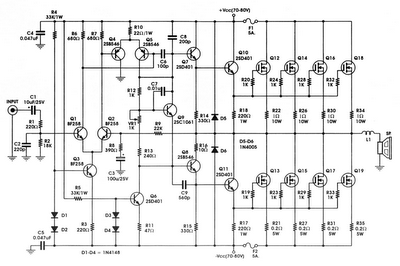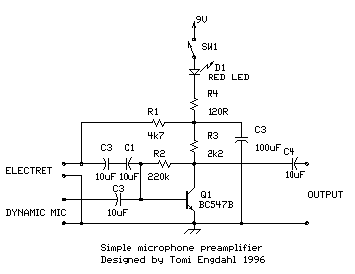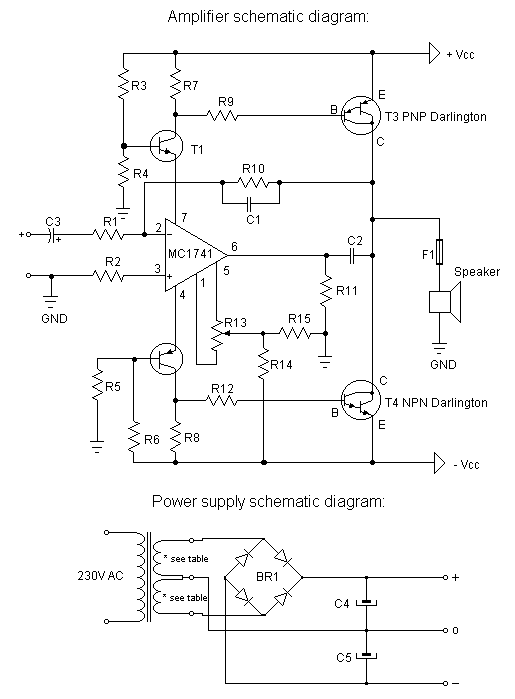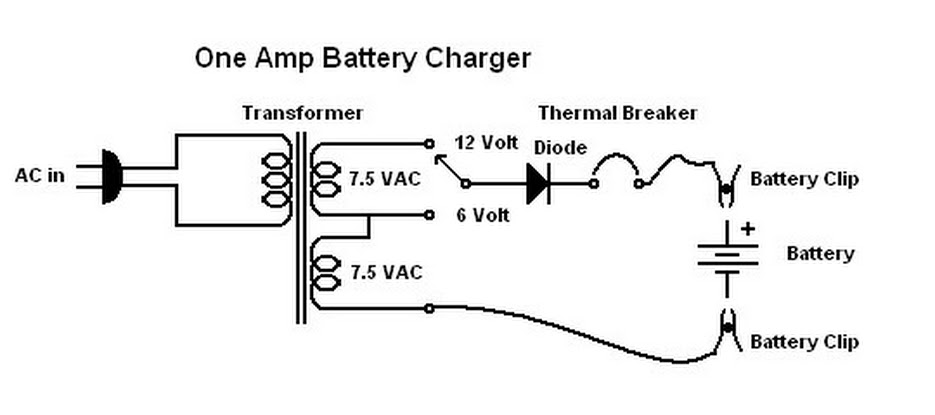
1N5401 3.0 AMP Silicon Rectifier
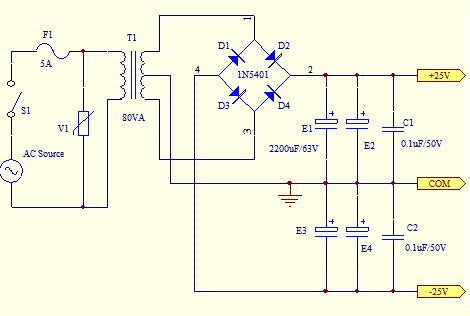
The schematic illustrates how +25V DC and -25V DC are generated to supply power to two stereo amplifiers. An 80VA power transformer with a 240V/36V center-tapped secondary winding is utilized. The secondary output of the transformer is rectified using four 1N5401 diodes. The circuit activates a signal lamp upon detecting a line current consumption exceeding 5 mA and is designed to handle currents of several amperes with appropriate diodes in positions D1 and D2. Transistor T1 is activated when the voltage drop across D1 and D2 surpasses a specific threshold. The default configuration of the 78xx series voltage regulator provides a maximum current output of 1A to 1.5A. To enhance the current output of this regulator, an alternative circuit design is proposed. The parts list includes: R1, R2 = 4.7 kΩ; C1, C2 = 4700 µF / 16V; C3 = 47,000 µF / 35V; D1, D2, D3 = 1N5401 (3 Amp Diodes).
The circuit design begins with a power transformer that converts the mains voltage (240V) to a lower voltage (36V) suitable for the amplifiers. The center-tapped configuration allows for the generation of both +25V and -25V outputs, creating a dual power supply necessary for the operation of the stereo amplifiers. The rectification process employs four 1N5401 diodes arranged in a full-wave bridge configuration. This setup ensures efficient conversion of the alternating current (AC) from the transformer into direct current (DC), providing a stable power supply.
The circuit also features a current detection mechanism. When the current consumption exceeds 5 mA, a signal lamp is illuminated, indicating that the amplifiers are drawing power. The design incorporates diodes D1 and D2, which are capable of handling higher current loads, thus ensuring reliability and durability under varying operational conditions. The transistor T1 plays a critical role in this circuit; it is activated by the voltage drop across D1 and D2, enabling further control over the circuit's functionality.
Additionally, the voltage regulation is managed by the 78xx series regulators, which are known for their robustness and ease of use. These regulators typically provide a maximum output current between 1A and 1.5A. For applications requiring higher current outputs, modifications to the circuit can be made to accommodate additional components or configurations that enhance the current capacity.
The components listed in the parts list are crucial for the circuit's operation. Resistors R1 and R2, with a value of 4.7 kΩ each, are used for current limiting and biasing purposes. Capacitors C1 and C2, rated at 4700 µF / 16V, serve to smooth the rectified output, while C3, with a higher capacitance of 47,000 µF / 35V, provides additional filtering to ensure a stable DC voltage. The diodes, rated at 3 Amps, are robust enough to handle the expected current loads, ensuring the reliability of the power supply circuit within the audio amplification system.The schematic below shows how the +25V DC and -25V DC are obtained. In order to provide power supply for 2 stereo amplifiers, a power transformer rating of 80VA with 240V/36V centre tapped secondary winding is used. The secondary output of the transformer is rectified by using four 1N5401 diodes toge. The circuit in Fig. 56-11a lights the signal la mp upon detecting a line current consumption of more than 5 mA, and handles currents of several amperes with appropriate diodes fitted in the Dl and D2 positions. Transistor T1 is switched on when the drop across D1/D2 exceeds a certain level. Diodes fr. By default, the regulator ID 78xx series will give maximum current output 1A – 1. 5A. To increase the current output of this regulator, you may consider this circuit. Parts list:R1, R2 = 4. 7 KC1, C2 = 4700 uF / 16VC3 = 47, 000 uF / 35VD1, D2, D3 = 1N5401 ( 3 Amp Diodes )D4 & D5 –. 🔗 External reference
The circuit design begins with a power transformer that converts the mains voltage (240V) to a lower voltage (36V) suitable for the amplifiers. The center-tapped configuration allows for the generation of both +25V and -25V outputs, creating a dual power supply necessary for the operation of the stereo amplifiers. The rectification process employs four 1N5401 diodes arranged in a full-wave bridge configuration. This setup ensures efficient conversion of the alternating current (AC) from the transformer into direct current (DC), providing a stable power supply.
The circuit also features a current detection mechanism. When the current consumption exceeds 5 mA, a signal lamp is illuminated, indicating that the amplifiers are drawing power. The design incorporates diodes D1 and D2, which are capable of handling higher current loads, thus ensuring reliability and durability under varying operational conditions. The transistor T1 plays a critical role in this circuit; it is activated by the voltage drop across D1 and D2, enabling further control over the circuit's functionality.
Additionally, the voltage regulation is managed by the 78xx series regulators, which are known for their robustness and ease of use. These regulators typically provide a maximum output current between 1A and 1.5A. For applications requiring higher current outputs, modifications to the circuit can be made to accommodate additional components or configurations that enhance the current capacity.
The components listed in the parts list are crucial for the circuit's operation. Resistors R1 and R2, with a value of 4.7 kΩ each, are used for current limiting and biasing purposes. Capacitors C1 and C2, rated at 4700 µF / 16V, serve to smooth the rectified output, while C3, with a higher capacitance of 47,000 µF / 35V, provides additional filtering to ensure a stable DC voltage. The diodes, rated at 3 Amps, are robust enough to handle the expected current loads, ensuring the reliability of the power supply circuit within the audio amplification system.The schematic below shows how the +25V DC and -25V DC are obtained. In order to provide power supply for 2 stereo amplifiers, a power transformer rating of 80VA with 240V/36V centre tapped secondary winding is used. The secondary output of the transformer is rectified by using four 1N5401 diodes toge. The circuit in Fig. 56-11a lights the signal la mp upon detecting a line current consumption of more than 5 mA, and handles currents of several amperes with appropriate diodes fitted in the Dl and D2 positions. Transistor T1 is switched on when the drop across D1/D2 exceeds a certain level. Diodes fr. By default, the regulator ID 78xx series will give maximum current output 1A – 1. 5A. To increase the current output of this regulator, you may consider this circuit. Parts list:R1, R2 = 4. 7 KC1, C2 = 4700 uF / 16VC3 = 47, 000 uF / 35VD1, D2, D3 = 1N5401 ( 3 Amp Diodes )D4 & D5 –. 🔗 External reference
